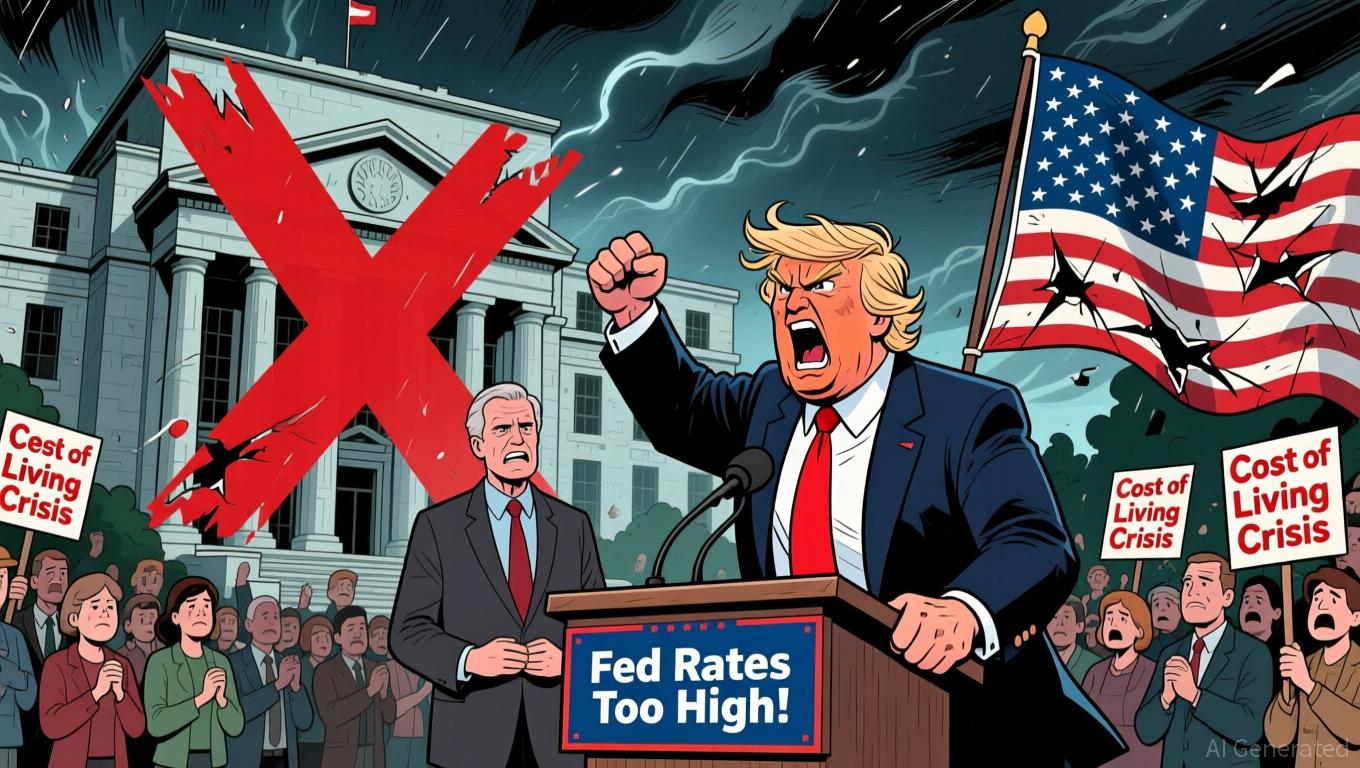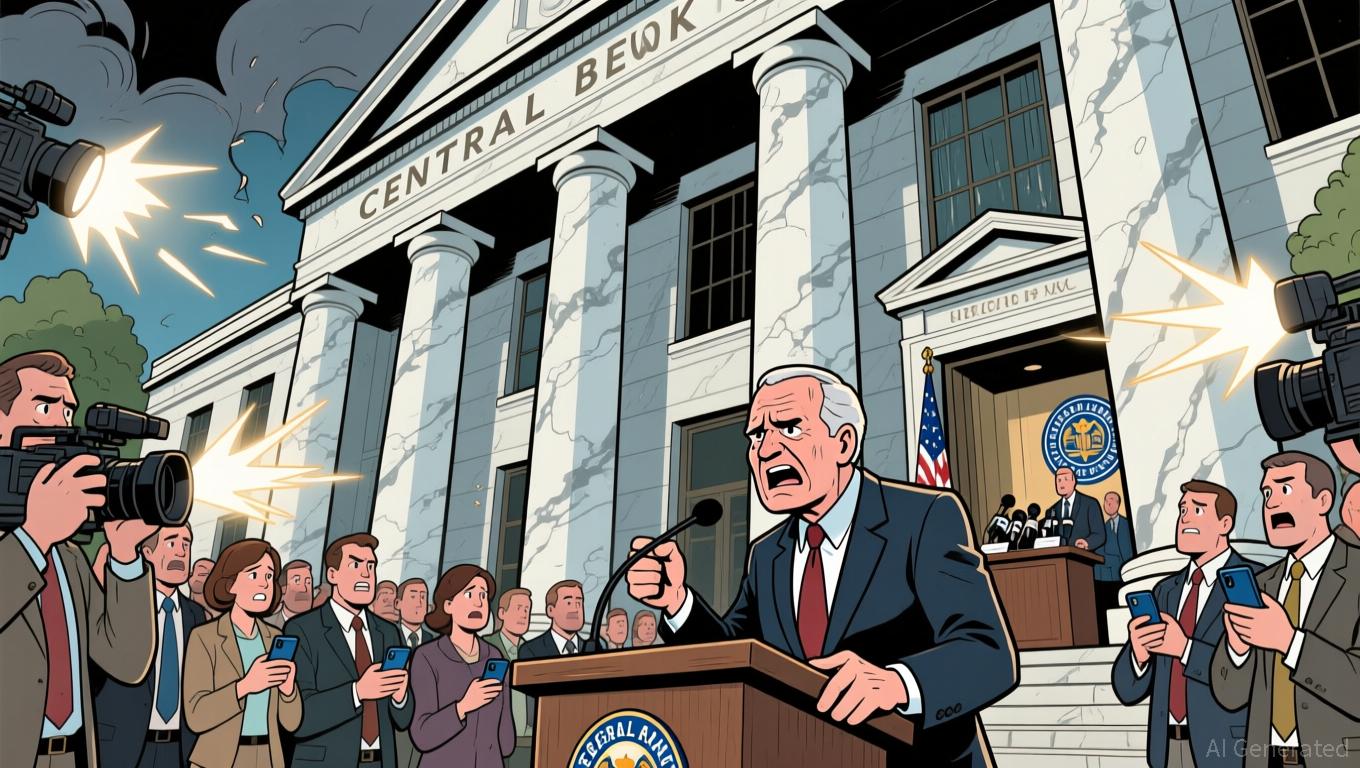Trump’s Dispute with the Fed Highlights the Strain Between Political Influence and Central Bank Autonomy
- Trump publicly criticized Fed Chair Powell, threatening to fire him over high rates. - Bessent highlighted tariff cuts on food imports and proposed $2,000 rebate checks to address affordability. - The Fed’s independence faces political pressure as Trump’s economic agenda clashes with monetary policy. - Trump’s rhetoric underscores tensions between presidential authority and central bank autonomy ahead of 2026 midterms.
On Wednesday, President Donald Trump intensified his open attacks on the Federal Reserve, issuing a direct warning to Treasury Secretary Scott Bessent that the issue of high interest rates must be resolved or there would be serious repercussions. Speaking at a prominent U.S.-Saudi Investment Forum in Washington, D.C., Trump labeled Federal Reserve Chair Jerome Powell as "grossly incompetent" and stated, "If you don't sort this out quickly, I'll have to fire you. OK?" These comments highlighted Trump's ongoing dissatisfaction with the Fed's monetary decisions and increased the pressure on his administration to push for lower borrowing costs as inflation worries persist
The president's remarks came during a meeting with Saudi Crown Prince Mohammed bin Salman, who, at the same event, pledged to invest $1 trillion in the United States. Despite the international focus, Trump shifted the conversation to domestic economic matters, criticizing the Fed's recent choice to keep interest rates high. "Rates are just too high," he insisted, blaming Powell for wasting $4 billion on what he called a "tiny building" for the Fed's headquarters. Trump once again called for rate reductions, contending that elevated borrowing costs worsen the financial burden on Americans. "Mortgages and car loans are unaffordable," he continued,

Bessent, who previously worked as a hedge fund executive and now serves as Trump's Treasury Secretary, has played a central role in the administration's anti-inflation efforts.
Trump's statements at the forum came after a turbulent week for his administration. The president has repeatedly referred to Powell as "stupid" and "too late Powell," intensifying demands for rate cuts as his economic approval ratings slip.
The administration's economic plans have encountered obstacles beyond the Federal Reserve.
As Trump continues to present his economic agenda as a response to inflation and affordability issues, his public disputes with the Fed underscore the ongoing friction between political leaders and the central bank's independence. With the 2026 midterm elections drawing closer, the administration's success in fulfilling these promises may determine the direction of its economic strategy and the future autonomy of the Federal Reserve.
Disclaimer: The content of this article solely reflects the author's opinion and does not represent the platform in any capacity. This article is not intended to serve as a reference for making investment decisions.
You may also like
Fed's Split Opinions and Incomplete Data Obscure Prospects for Rate Reduction
- Fed's December rate cut odds drop to 39.6% due to missing October jobs data and inflation uncertainty. - Market jitters rise as gold falls, dollar strengthens, and crypto faces pressure amid policy uncertainty. - Fed factions debate inflation control vs labor support, with CME pricing 44% chance of 25-basis-point cut. - Central bank plans to end quantitative tightening in December, but data gaps complicate policy calibration. - 2026 may see slower easing cycle as investors monitor November payrolls and F

$40K Gas Fee Turns Into $1M Gain: Jesse Token Sniping Highlights Barriers to Entry in Crypto
- An address paid $40K in gas fees to secure 7.6% of Jesse token, netting $1M profit after selling its stake. - The "scientist" actor exploited advanced tools to front-run Jesse's token sale, highlighting DeFi's competitive "sniping" dynamics. - High gas fees and technical barriers concentrate token sale opportunities among well-resourced participants, raising accessibility concerns. - Jesse token's launch, led by Base co-founder, reflects broader crypto trends where strategic timing and resources drive sp

Bitcoin's Latest Price Fluctuations and Growing Institutional Interest: Optimal Timing for Investment as Regulations Become Clearer and Economic Conditions Evolve
- Bitcoin's 2025 volatility reflects institutionalization, with $11B in Q3-Q4 2025 ETF inflows and corporate buyers like MicroStrategy accumulating BTC. - Regulatory clarity via the GENIUS Act and Tether's Latin American expansion accelerated institutional adoption, despite U.S. state-level restrictions creating short-term uncertainty. - Macroeconomic tailwinds including Fed rate cuts and $96T global M2 money supply supported Bitcoin's $200,000 price target, lowering capital costs for long-term holdings. -
Solana’s Latest Price Rally: Could This Signal the Beginning of Another Bull Market?
- Solana's 2025 upgrades (Firedancer, Alpenglow, ZK Compression v2) enhance scalability to 1M TPS and reduce costs by 5,200x, positioning it for institutional adoption. - Institutional partnerships with Western Union (USDPT), Google Cloud, and ETFs (BSOL/GSOL) drive $111M inflows and validate Solana as a financial infrastructure backbone. - While SOL trades at $141 under bearish pressure, technical upgrades and real-world use cases suggest long-term growth potential beyond speculative trading cycles.